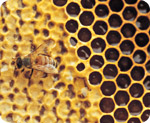
The Truth About Honeybees Provide Clues to Their Disappearance
Thursday, January 24, 2008 by: Laura Weldon
Tags: honeybees, health news, Natural News
- Oncologist warns of ‘terrifyingly aggressive’ cancers in children, linked to immune suppression from COVID vaccines
- NIH study, buried for decades, reveals that Flu Shots INCREASE elderly deaths, not prevent them
- COVID-19 scandal linked to CANCER SURGE: Billionaire researcher sounds alarm
- Musk targets “strangely wealthy” lawmakers in DOGE probe, names Pelosi, McConnell, Schumer
- Ancient kitchen secrets REVEALED: How garlic, ginger and green onions fight cancer and heart disease
- DARPA: The shadowy innovator behind the world’s most advanced military technologies
- Millionaire fitness coach charged in Tesla vandalism incident as anti-Musk attacks escalate
- “Ethically sourced” human “bodyoids” could usher in a new era of medical exploitation, raising disturbing ethical questions
- Newly released JFK files reveal Pentagon's role in creating Lyme disease and covid in the same lab
- European Court of Justice: Healthcare professionals who promoted or administered COVID-19 vaccines are CRIMINALLY LIABLE for any harm caused
- Britain’s descent into police state censorship: Parents raided for questioning their daughter’s school system online
- RFK Jr. is pushing Big Pharma ad ban - and corporate media is panicking
- Tackling the rubber waste crisis: Groundbreaking study reveals eco-friendly method to recycle tires
- Homesteading Boom: How families are escaping cities to grow their own food
- Joseph Farrell’s “The Cosmic War”: Did an interplanetary conflict reshape the solar system?
- NYT admits U.S. ran Ukraine war operations-Russia's victory exposes obsolete NATO tactics, says Mike Adams
- Utah governor allows ban on LGBT pride flags in public buildings and schools, will take effect without his signature
- Civil war is here – Multiple events, from conservatives being “swatted,” to attacks against Telsa owners, happening across America as Dem politicians are telling supporters to ‘fight in the streets”
- Newly released JFK files reveal Pentagon's role in creating Lyme disease and covid in the same lab
- CDC finally halts $11 billion COVID funding scam as health officials admit the ‘pandemic’ was a fraud
- Analysis: The coming economic collapse, a mass uprising and Trump's three secret weapons to halt the growing revolt
- Kiss Your Genetic Privacy Good-Bye! 23andMe Gets Green Light to Sell Your Intimate Genetic Details to Anyone They Want
- Dr. Suzanne Humphries makes bombshell appearance on Joe Rogan podcast, exposing vaccine industry deception back to POLIOMYELITIS
- DEADLY DECEPTION: How COVID vaccines increased mortality rates and why authorities hid the truth
- Woman contracts WORLD'S DEADLIEST VIRUS after unknowingly being given the WRONG VACCINE
- Oncologist warns of ‘terrifyingly aggressive’ cancers in children, linked to immune suppression from COVID vaccines
- Here are TEN all-natural ways to protect your garden without using harmful chemicals
- Black cumin seed oil emerges as a powerful ally against breast cancer and chronic inflammation
- The hidden dangers in your kitchen: How cooking methods impact diabetes, cancer and aging
- Trump's greatest betrayal so far: Accelerating Middle East wars, silencing dissent, and serving Zionist masters
- Senate Democrats deny censorship industrial complex existed, defend government's role in silencing dissent
- Sugar-free deception: Artificial sweeteners hijack hunger signals, fuel obesity epidemic, study warns
- “Independent” anti-Russia outlet MEDUZA faces COLLAPSE as US funding dries up
- NIH study, buried for decades, reveals that Flu Shots INCREASE elderly deaths, not prevent them
- The Health Ranger releases “Vaccine Zombie” song and music video, using AI-animated zombies for the music video
- Discovery of vast underground city beneath Giza pyramids challenges human history
- Newly released JFK files reveal Pentagon's role in creating Lyme disease and covid in the same lab
- California's social media censorship law struck down: A victory for free speech or a threat to online safety?
- EPA advisor admits the agency is funneling billions to climate groups ahead of Trump’s return to White House
- The Health Ranger releases “Vaccine Zombie” song and music video, using AI-animated zombies for the music video
- Dr. Mike Yeadon releases 15-minute testimony - WATCH - about genocidal intent of COVID “vaccines”
- Florida takes a stand: DeSantis proposes permanent ban on mRNA vaccine mandates
- Mike Adams releases country western hit single: Goin’ Back in Time is Comin’ Home
- “Why we influenced the 2020 elections”: Facebook files reveal the coordinated effort to bury the Hunter Biden laptop story
- Unpacking the Lies That We’ve Been Fed – new song and music video released by Mike Adams, the Health Ranger
- House Intelligence Committee calls for the ARREST and PROSECUTION of Dr. Anthony Fauci
- The pandemic as a tool for INDOCTRINATION: Understanding “The Indoctrinated Brain” by Dr. Michael Nehls
- Rep. Nancy Mace introduces bill to ban biological males from female facilities on federal property
- Mike Adams releases music poetry sensation: A Child of God
- Sugarcane extract superior to cholesterol-lowering drugs?
- Survival 101: Effective EMF blocking techniques
- Michigan sheriff announces criminal investigation into 2020 election crimes, Dominion Voting Systems
- Peter Rost exposes Big Pharma corruption in his book “The Whistleblower: Confessions of a Healthcare Hitman”
- Migrants are taking advantage of recent hurricanes to scam residents and loot their homes
- Red Cross issues warning to stop blood plasma donations from vaccinated people
- Scientists confirm: GENIUS brain function can be spontaneously unleashed in humans without any apparent cause
- EPA advisor admits the agency is funneling billions to climate groups ahead of Trump’s return to White House
- HYSSOP: What research reveals about the health benefits of this ancient holy herb
- Two containers with completed ballots fall out of truck in Florida
- Fully vaccinated about to see “tsunami” of illness and death, warns virologist
- Global leaders unite to clamp down on “misinformation” with UN-backed Cascais Declaration
- BREAKING: 2025 NDAA authorizes mandatory military draft of WOMEN across America… as Pentagon pursues global NUCLEAR war with both Russia and China at the same time
- Michael Yon warns of a ZIONIST TAKEOVER in Trump’s second administration
- BOMBSHELL: DNA testing kits are a SCAM to develop ethnic-specific bioweapons
- Ozempic and Wegovy weight loss drugs are injectable LIZARD VENOM PEPTIDES that may unleash a devastating wave of organ failure… side effects align with symptoms of SNAKE BITES
- Israeli soldiers accused of even more torture and abuse in the West Bank
- These 13 countries just signed an agreement to engineer a global FAMINE by destroying food supply
- NASA admits that climate change occurs because of changes in Earth’s solar orbit, and NOT because of SUVs and fossil fuels
- RFK Jr. clears key hurdle: Sen. Susan Collins backs controversial HHS nominee, signaling a new era for health policy
- Sermon 30: How Jesus reveals Caesar’s FAKE CURRENCY and FALSE AUTHORITY
- Coriander seeds: Ancient medicine backed by modern science
- Arizona officials claim Maricopa County needs 10-13 days to tabulate results of the election
CCD hit hard last winter. By spring of 2007 a quarter of U.S. beekeepers reported losing at least 45 percent of their bees. Some lost 100 percent. The disorder has been found in 35 states, Canadian provinces and parts of Europe, Asia and South America. As Gale Buchanan, USDA undersecretary for Research, Education and Economics, says, "Bee populations throughout the United States are in serious decline." Her agency has appropriated four million dollars to research the problem.
Articles on this syndrome continue to note that it is a "mystery" that scientists have not yet pinpointed. So far it has been blamed on everything from a rogue virus to the electromagnetic frequencies emitted by cell phone towers.
But if we are willing to examine the problem holistically we might see what apiary management specialists, entomologists and agronomists are missing. We got into this mess by making assumptions that have no basis in reality. Our hubris has led us to imagine that we can subvert nature to our own uses. And that has led to serious consequences.
First Assumption: Honey is one of nature's perfect products.
Reality: True. A worker bee makes, on average, about one-twelfth of a teaspoon of honey in her lifetime. This miracle elixir contains vitamins, minerals, enzymes and antioxidants. Honey has proven beneficial for sustaining health as well as treating wounds, allergies and other conditions. Raw honey is preferable, before these properties are altered by heat.
But you have to make sure you are getting one of nature's perfect products in the first place. The best source of honey is a local beekeeper, not a big box store. Why? Because you want the jar labeled "honey" to contain nothing but pure honey. That isn't always the case.
The U.S. imports millions of pounds of honey from China, but the product isn't necessarily unadulterated honey. As consumers it's informative to learn what goes on behind the scenes. The global food brokerage firm, S. Kamberg & Company Ltd., warns businesses purchasing imports about products sold as honey. S. Kamberg's site at (http://skamberg.com/honey.htm) recently reported, "There was not a lot of 'real honey' coming into USA from China until last month when the U.S. imported over 4 million lbs. The USA had previously been receiving a lot of packer's syrup from China (honey blended with other sugar syrups). It is uncertain if this was actual packer's syrup, or possibly actual honey sold as packer's syrup to avoid duties. The probability is high that any actual packer's syrup entering this country would be blended with and sold as real honey."
In other words, if you thought you were getting a good deal on honey, it may not have been honey. Just a product cheap enough to undercut the price of local honey.
Second Assumption: Okay then, we'll buy local honey and help support beekeepers.
We remember watching documentaries about bees dancing to tell hive mates about good sources of food. We know that many plants rely on pollinators flitting from flower to flower. After all, bees collect nectar to make honey which we then enjoy in our morning smoothies.
Reality: Honey is the least of the matter. According to the USDA, about a third of what we eat requires insect pollination. Honeybees handle 80 percent of the job. That means almonds, strawberries, broccoli, soybeans, cantaloupe, peaches and more for a total of 130 crops. Bees contribute over $15 billion to the annual U.S. food production.
Third Assumption: Then that means bees, with their tireless work ethic, are our insect allies in food production. Without them agriculture is doomed!
Reality: We've steered things in that direction. First we need to recognize that the honeybee is actually not native to North America. It was brought from Europe for honey production over four hundred years ago. Of course, many of the crops that bees now pollinate are not native to this continent either.
Secondly, it's vital to acknowledge that there are actually over 4,000 pollinators native to this land such as butterflies, moths and bees. That includes many solitary bees such as mason bees and bumble bees. Most are solitary insects. These native pollinators require different types of nesting areas - sandy soil, fallen logs, rough grasses or undergrowth - the sort of "untended" land that can support diverse species. These are exactly the kinds of habitats that have been disappearing over the last 100 or so years under housing developments, roads, shopping centers and vast tracts of agribusiness style farms.
These pollinating insects also require food. They forage for nectar on plants in bloom throughout the growing season. Often the only blooms available in an area are what we call "weeds", thus these plants are sprayed or pulled up. Plus, modern farming practices starve these pollinators because they eliminate hedgerows between fields, and worse yet, maintain hundreds or thousands of acres of monoculture fields that bloom for the same few weeks per year. For more information check out (www.xerces.org) .
Fourth Assumption: Well the crops must get pollinated somehow. After all, I manage to buy almonds and strawberries without any problem.
Reality: These large monoculture crops are like ICU patients. A normal range of minerals in the soil - depleted. A balance of microbial life, healthy insect populations and other typical creatures - gone. And as we mentioned, no plants other than the main crop survive so there's nothing for pollinators to live on except those few weeks a year when the crop blooms.
So bees are brought in. Beekeepers make a lot more money providing pollination services than from selling honey. During the growing season trucks literally hum down our roadways filled with beehives. Tens of thousands of hives are needed in Maine for the blueberry crop, in the Carolinas for the peach crop and in New York for the apple crop. The mother of all pollination events takes place in California. Almond orchards cover more than 600,000 acres in that state. There the nuts are harvested with mechanical tree shakers, left to dry on the bare ground, then gathered by machine into a huller. The ground is therefore kept bare. Nothing grows, nothing that could support a pollinator except for the few weeks a year when the almond trees bloom. More than half of all U.S. honeybees are trucked to almond orchards, from many distant points in the country. A long ride even for those of us who like road trips.
Bees, however, are more the homebody types. They evolved to live in trees and other such shelters, making them easily domesticated. For about half of their short lives worker bees tend to tasks within the hive. As they get older and take on foraging duties they range up to a mile or so from the hive using highly evolved systems of navigation that may incorporate magnetic fields and cognitive mapping of the area. Even if hives are set in rows of hundreds in a large apiary, each worker bee always knows her own hive and has allegiance to her own queen. If she enters the wrong hive she will be repelled and likely killed as an invader. Traditional beekeeping books advise against moving a hive more than a few inches during the growing season so that worker bees, laden with nectar and pollen, can fly directly to the hive entrance.
Not any more. Before a move the hive entrances are covered, heavy equipment stacks hundreds of hives onto pallets one atop another and loads them on a truck. Then they hit the road, through all kinds of weather conditions, leaving the bees unable to forage or maintain crucial temperatures. They may be traveling for days with limited or questionable water supplies. And after a week or two in an area experiencing bloom, they'll be on the road again. This practice is called migratory beekeeping.
Interestingly, migratory beekeepers are experiencing the greatest losses from CCD.
Fifth Assumption: But migratory beekeeping can't be all that damaging. After all, it brings bees to the food.
Reality: This practice is hardly beneficial to the bees. It is enormously stressful. Pay attention to the word "stress" because it relates to modern beekeeping practices in many ways, not the least of which how it severs the link between bees and their forage choices.
Bees have evolved to live on nectar and pollen brought in from a variety of forage sources found in a balanced ecosystem. Bees will fly farther in search of different blooms if large amounts of nectar have already been gathered from one type of plant, presumably to balance the nutrient levels of the resulting honey. When bees are exposed to single plant sources repeatedly, they do not have a full range of vitamins and minerals to raise a healthy brood or maintain strong immune systems any more than we would survive well on a diet of nothing but bananas. Bees need to feed on a wide diversity of blooms.
But not only are bees repeatedly forced by migratory beekeeping to forage on monoculture farms, thereby gathering only one type of nectar for weeks on end, they are also typically fed corn syrup or sugar solutions. This highlights a practice used by most commercial beekeepers. They tend to harvest too much honey, and then they supplement the bees with these non-nutritious foods that are devoid of the wide range of vitamins, minerals, amino acids and enzymes found in honey. After decades of these practices it's no wonder that the current generations of bees are weak, increasingly susceptible to pests and diseases.
Moreover, that very corn syrup is made out of corn that is most likely from genetically modified (GM) corn. In the U.S. about half the corn crop is GM. These GM crops are planted in the first place because they are herbicide resistant and/or insect resistant. And what are bees? Insects. The scientific data does not currently show that GM crops are a danger to bees. So far what we do know is that GM crops overtly harm certain species of butterflies (also our pollinator friends). But this research does not test the long-term effect of bees fed GM corn syrup. We may be seeing the facts gathering irrefutably right in front of us.
None of us really knows what subtle link there may be between GM crops and CCD. But then, we also don't know how much of the GM research in general has been financed by the multinational corporations developing and benefiting from GM products. The moneyed lobbies of Monsanto, Dow and DuPont have insured that U.S. regulatory agencies do not impose labeling standards on GM foods nor protect the environment from GM plants cross-pollinating with other species. GM crops are highly lucrative. They are linked to expensive herbicides applied on a schedule. GM seeds cannot be saved and replanted as farmers have done throughout history. Sales of GM crops to farmers in the developing world increase every year. GM crops are planted on about 25 percent of the world's available acreage, totaling approximately 167 million acres. Of that, the U.S. has planted GM crops on about 105 million acres. In fact 85 percent of the U.S. soybean crop is now GM. And that crop requires pollination as well.
Sixth Assumption: Well at least we care about bees. Look, we even make cute animated movies about them.
Reality: Bees are essentially treated like livestock, although they are much more fragile than any other farm animal.
We know that honeybees live in marvelously complex colonies. Worker bees graduate from simple to more complex tasks. They care for their brood, protect the hive, create perfectly structured hexagonal chambers and forage for nectar.
Bees are able to regulate the temperature of the hive throughout the seasons. In the winter the bees cluster around the queen and take turns moving to the cold exterior of the cluster. In the summer they cool the hive and dehydrate the nectar into honey by fanning their wings. If the temperature of the hive rises due to extreme summer temperatures the bees, via an unknown signal, alert all hive members. In response the bees stop what they are doing, even those that are foraging for nectar at a great distance. These tiny insects each collect a drop of water to bring back to the hive to cool it, rushing back and forth with a cargo of moisture until the heat emergency is over.
The queen bee is the hub of the hive. As a virgin she flies free and mates in the air with drones. Research has found that the more drones inseminate her, the better the outcome in subsequent hive health. After that mating flight the queen returns to the darkness of the hive and spends the rest of her life, sometimes several years, laying hundreds of eggs a day.
Unfortunately this beautifully natural organization of the hive is often subverted by modern beekeeping techniques. Bees cannot regulate the hive temperature when the hive is closed for transport. Beekeepers commonly kill the queen each year by opening the hive and crushing her, presumably to strengthen the colony with a younger queen. But they don't wait for the colony to hatch a virgin queen of its own. They introduce an artificially inseminated queen that has been purchased and shipped, often from across the country. This practice does not allow the strength of a local population to build, nor does it encourage the natural resilience developed by multiple inseminations. And of course, as previously noted, bees are fed with sugar or corn syrup to replace some of the food they rely on, honey.
Seventh Assumption: That's a stretch to say that bees are treated like livestock.
After all, bees have it a lot better than say cows. At least no one is treating them with chemicals and medications.
Reality: Bad news there. Over the past few decades something has substantially weakened bees. Or more likely, a host of factors has weakened them. Infestations of disease and parasites are now common. Small hive beetle, tracheal mites, nosema, varroa mites, American foulbrood, chalkbrood, acute paralysis virus, the list could go on. Beekeepers can barely keep up. They treat with medications and pesticides right in the hive. The chemicals work for a period of time before losing effectiveness. Then the situation often worsens. In the last thirty years thousands of beekeepers have gone out of business as these diseases and pests have wiped out their bees.
Of course, fifth grade students studying biology can explain how resistance builds. Treat a pest like tracheal mites with a chemical designed to kill them but preserve the host, in this case the bee. Initially the chemical seems like a miracle cure, wiping out the majority of mites. But the surviving mites require more of the chemical to kill them. And still some survive. They are resistant. Beekeepers continue to use the chemical in larger doses or as a preventive measure, unaware of the long-term effect on the bees. Meanwhile the resistant mites reproduce, passing along their resistant traits, and new chemicals must be developed to destroy them. Natural resistance, on the other hand, prescribes strengthening the host (the bee) to ward off the pest. Less hardy bees may die but the remaining bees are more resistant to the pest. Efforts to reduce any factors that stress the host's health and immunity are paramount because the mites cannot flourish on these healthy bees. That's natural resistance.
In fact, beekeepers know that viruses often exist in healthy colonies. Several years ago a European study found a high prevalence of conditions such as deformed wing virus, sacbrood virus and acute bee paralysis virus in thriving, producing colonies. These viruses co-exist with the insects in a strong hive. They are known to overwhelm bees when other conditions weaken them.
This discussion of enemies within the hive doesn't even mention the pesticides used on crops. Bees are highly susceptible to these chemicals, both in active spraying and systemic residue in plants. A French study found that bees raised in cities are actually healthier than their counterparts living in the countryside, and credit the difference to the deleterious effect of agricultural chemicals.
Eighth Assumption: Okay, so all of these factors added up are pretty serious. Mother Nature is telling us to stop messing with her. Science will show us how to solve this.
Reality: It might seem to us that CCD has to do with the cumulative result of many factors working against the very nature of bees, ultimately stressing them to the point of mortal weakness. But these days science is rarely about the big picture.
Recent studies have tried to pin CCD on the Israeli acute paralysis virus, without total success. It turns out the same strain have been in the U.S. since at least 2002. Other research has pointed to other viruses, pathogens or infestations. But the way some studies were conducted is questionable. Some did no follow up or limited follow up. Others were poorly designed. For example, one study introduced healthy colonies of bees to hive boxes that had been CCD hives. Half of the empty hives had been irradiated to kill pathogens. When new colonies of bees were introduced it was found that they were healthier in these irradiated hives. But that study did not factor in the effect of irradiation on pesticide residue. Many pesticides break down rapidly in sunlight and would also do so in the presence of radiation, introducing an unknown factor into the study.
Diana Cox-Foster of Penn State commented in a press conference that they had found no correlation between CCD and any specific pesticide. But Dr. Cox-Foster also said, "in terms of chemical pesticides, the data there suggests that perhaps those could be helping to stress the bees, or acting as a potential trigger. We have some data from our lab suggesting that some classes of pesticides may cause amplification of specific viruses, not all."
Other researchers have noted that stress caused by migratory beekeeping practices may be related in an unknown way to the incidence of CCD.
May Berenbaum, head entomologist at the University of Illinois, says, "The causes of CCD are complex, and there probably isn't any single thing that will solve it."
Exactly. Someday science may pin CCD down to one thing. But the sorry state of domestic bees today has a lot to do with what is wrong with the environment, agriculture and beekeeping practices. Our human preoccupation with what is most profitable and expedient comes at a great expense.
U.S.D.A. researchers have had success using wild bees to pollinate alfalfa crops even before CCD hit. Now they are at work on techniques to manage breeding of wild bees for widespread commercial use. Sound familiar?
Meanwhile, science, academia and industry have paired up to introduce a new product designed to help today's beekeepers. It's called "SuperBoost." Let's just quote from the product release: "When SuperBoost is placed in a bee hive in the form of a small all-natural pheromone release device, it will:
* increase the pollen load each foraging worker brings back to the hive by up to 100%
* increase the number of pollen foragers by up to 150%
* increase pollen foraging on the target crop by 43%
* increase pollination activity of non-pollen foragers on the target crop by 54%
* increase the number of pollen foraging trips per unit time by up to 72%
* increase the colony growth rate in the summer and winter
* lower the age of first foraging by worker honey bees, and increase the overall health of the hive."
Now who on earth would come up with a product to force today's stressed out, diseased and dying domestic bees into overdrive? Turns out the product is a result of collaboration between Texas A&M University, a company called Pherotech International, and one of the monoculture champions, The Almond Board of California. Supply your own ironic observations.
Throughout history bees have been recognized as keepers of deeper truths. They were said to symbolize fertility, love and mysticism associated with nature goddesses. The ancient Greeks and Egyptians wrote of them as representing the soul and immortality. They are mentioned in scriptures sacred to Muslims, Buddhists and Christians. Honeybees have also been depicted as signs of healing, purity and divine guidance.
Many books about bees and beekeeping have been on bestseller lists in recent years. People seem to feel drawn to something about bees. What is it? Perhaps it's because bees are mysterious, tending to their queen in lives of unfathomable sacrifice. Or perhaps we resonate with the dual nature represented by the fear of stings and promise of honey. Or maybe we too wish to seek out and intensify that which is sweet. Whatever bees mean to us, we recognize that they need to live in harmony with nature. That's what we can learn from CCD.
How can we help?
Vote with your dollar. Buy organic, non-GM foods. Whenever possible purchase foods grown on small area farms. And support your local beekeepers by purchasing their products. Whenever possible buy organically hived, raw honey.
Invite a member of an area beekeeping club to speak with your gardening organization, schools, ecology group and others to increase awareness. Find a beekeeping club by checking the directory at (http://www.beeculture.com/content/whoswho/)
Contact a local beekeeper if you discover a swarm of honeybees near your home. Hiving a swarm is a community service provided by beekeepers.
Avoid using pesticides. If possible, leave plants (even weeds) alone in the blooming phase.
Leave wild areas for native pollinators to nest. If you have property, consider designating a portion as a wild area. Leave it unmowed, unweeded and alone. Even a small area will support a diversity of life and provide you with opportunities to enjoy watching birds, insects and other creatures. If you do not have a yard, influence your local schools, museums, businesses and city administration to set aside areas for natural growth.
Even tended areas can provide forage. Pollinators need plants in bloom throughout the growing season. Yards with flowers and diverse ground cover support pollinators. Flowering window boxes and pots on apartment balconies are also helpful.
Consider becoming a beekeeper. Small scale and urban beekeeping is undergoing a renaissance. Check out the new book, "Natural Beekeeping: Organic Approaches to Modern Apiculture" by Ross Conrad.
About the author
Laura Weldon lives on an organic farm and believes in bliss. Learn more about her book "Free Range Learning" by visiting at www.lauragraceweldon.comHoneybees at FETCH.news
Get independent news alerts on natural cures, food lab tests, cannabis medicine, science, robotics, drones, privacy and more.
Take Action: Support Natural News by linking to this article from your website
Permalink to this article:
Embed article link: (copy HTML code below):
Reprinting this article:
Non-commercial use OK, cite NaturalNews.com with clickable link.
Follow Natural News on Facebook, Twitter, Google Plus, and Pinterest
Science News & Studies
Medicine News and Information
Food News & Studies
Health News & Studies
Herbs News & Information
Pollution News & Studies
Cancer News & Studies
Climate News & Studies
Survival News & Information
Gear News & Information
News covering technology, stocks, hackers, and more



"Big Tech and mainstream media are constantly trying to silence the independent voices that dare to bring you the truth about toxic food ingredients, dangerous medications and the failed, fraudulent science of the profit-driven medical establishment.
Email is one of the best ways to make sure you stay informed, without the censorship of the tech giants (Google, Apple, Facebook, Twitter, YouTube, etc.). Stay informed and you'll even likely learn information that may help save your own life."
–The Health Ranger, Mike Adams












































